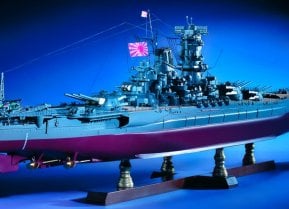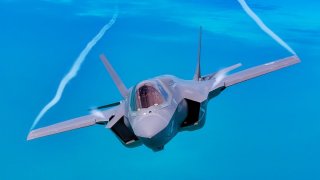Japan Now Has 'Mini' Aircraft Carriers Carrying F-35 Fighters
In a historic move, Japan is transforming its Izumo-class helicopter carriers, JS Izumo and JS Kaga, into what seems more and more like fully functional aircraft carriers capable of operating F-35B Lightning II jets.
Summary: In a historic move, Japan is transforming its Izumo-class helicopter carriers, JS Izumo and JS Kaga, into what seems more and more like fully functional aircraft carriers capable of operating F-35B Lightning II jets. This significant military upgrade, highlighted by the first-ever takeoff and landing of an F-35B on JS Izumo, marks Japan's return to fixed-wing aircraft carrier operations since World War II. Funded by Japan's largest defense budget request, this transformation aligns with Tokyo's acquisition of 42 F-35Bs, enhancing its defensive capabilities amidst rising tensions in the South China Sea and Korean waters. The Izumo-class destroyers, now aircraft carriers in disguise, underscore Japan's strategic pivot towards advanced naval air power.
Japan's Naval Evolution: Izumo-Class Carriers to Field F-35B Jets
In 2021, a U.S.-manufactured F-35B fighter jet conducted the first-ever takeoff and landing test on JS Izumo. This monumental event marked the first time a fixed-wing aircraft operated off a Japanese vessel since the Second World War. Since Japan first announced its plans to convert its Izumo-class helicopter carriers into aircraft carriers, the JS Kaga has commenced sea trials. In December, images published by The Escort Flotilla Four of Japan Marine United showcased the destroyer leaving its dock at the shipyard in Kure City, Hiroshima Prefecture. Beneath the picture, the Escort Flotilla noted, “Today’s post is about JS Kaga during sea trials. There is only a little time left until the special modification of JS Kaga is completed! We can’t wait!”
Japan’s Ministry of Defense revealed its largest fiscal year budget request in August. Requesting $52.9 billion, the ministry hopes that it will be enough to modify its two existing helicopter destroyers, JS Izumo and JS Kaga, into aircraft carriers, in addition to other defense needs. This announcement came alongside Japan’s plan to procure forty-two Lockheed Martin F-35B Short Take-Off and Vertical Landing (STOVL) fighters. Japan currently has the second-largest contingent of F-35 Lightning II airframes outside the U.S. Eventually, Tokyo plans to acquire additional F-35As down the line.
Introducing the Izumo-class destroyers:
The U.S. Naval Institute classifies Japan’s two Izumo-class destroyers as helicopter-carrying destroyers. Initially unveiled in 2013, the Izumo ships are the largest surface combatants of the Japan Maritime Self-Defense Force. Japan first announced plans to build these destroyers back in 2009, detailing that their primary mission would be in anti-submarine warfare and peacekeeping/disaster relief operations. The Japan Marine United Corporation (JMU) constructed both ships at the Yokohama shipyard. The lead ship was launched in 2013, followed by the Kaga in 2017.
Both Izumo ships measure roughly 248 meters in length, with a beam of thirty-eight meters and a displacement of 19,500 tons. Around 970 troops and crewmembers, in addition to nine helicopters, can be carried onboard simultaneously. In terms of armaments, the Izumo ships are quite formidable. According to Naval Technology, “The Izumo-class destroyer is fitted with two Phalanx close-in weapon system (CIWS) guns, and two SeaRAM CIWS launchers. It is also equipped with electronic warfare and decoy systems, including NOLQ-3D-1 EW suite, Mark 36 SRBOC, anti-torpedo mobile decoy (MOD) and floating acoustic jammer (FAJ).” Advanced sensors have also been incorporated into the carriers, including the OYQ-12 combat direction system, OPS-50 AESA radar, FCS-3 fire control system, and OPS-28 surface-search radar. The Izumo destroyers are powered by four GE/IHI LM2500IEC gas turbine engines, enabling the ships to sail at speeds exceeding thirty knots.
From helicopter carrier to aircraft carrier:
China once described Japan’s Izumo-class helicopter destroyers as “aircraft carriers in disguise.” Now that the vessels are being modified to be able to operate fifth-generation fighter jets, this characterization appears apt. The Japanese Cabinet first issued its approval for the ships’ transitions in 2018. One of the modifications underway is the reinforcement of the decks on both ships to support the additional weight of the Lightning II in addition to the heat and forces from fighter aircraft during vertical landing. JMU began the overhaul phase of Kaga in 2022 at the company’s shipyard in Kure. Other modifications being incorporated include adding more guidance lights, strengthening the flight deck to support additional weight, equipping the vessel with heat-resistant deck spots for vertical landing, and drawing yellow lines on the flight decks required for operating the Lightning II fighters. According to footage verified by the U.S. Naval Institute, Kaga has already completed a good portion of this modification work.
The F-35 Lightning II is arguably the most advanced fighter jet in the skies today. While the United States once monopolized air superiority technology, both China and Russia have developed their own fifth-generation airframes in recent years—the Chengdu J-20 and Sukhoi Su-57, respectively. Tensions continue to mount in the South China Sea and the Korean waters. Japan’s future ability to field F-35s from its makeshift aircraft carriers will be essential for deterrence and security.
About the Author: Maya Carlin
Maya Carlin, National Security Writer with The National Interest, is an analyst with the Center for Security Policy and a former Anna Sobol Levy Fellow at IDC Herzliya in Israel. She has by-lines in many publications, including The National Interest, Jerusalem Post, and Times of Israel. You can follow her on Twitter: @MayaCarlin.


